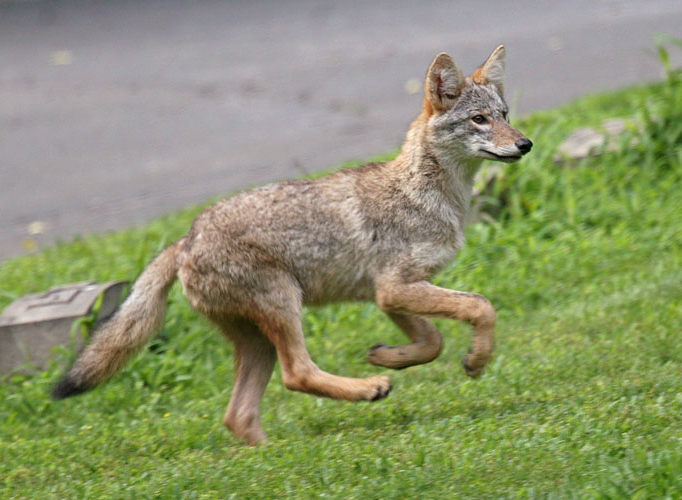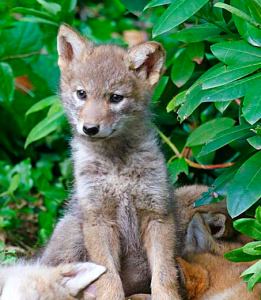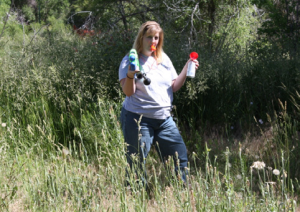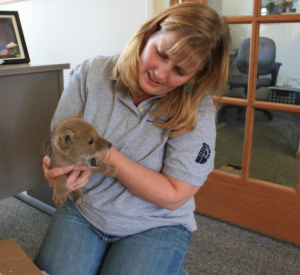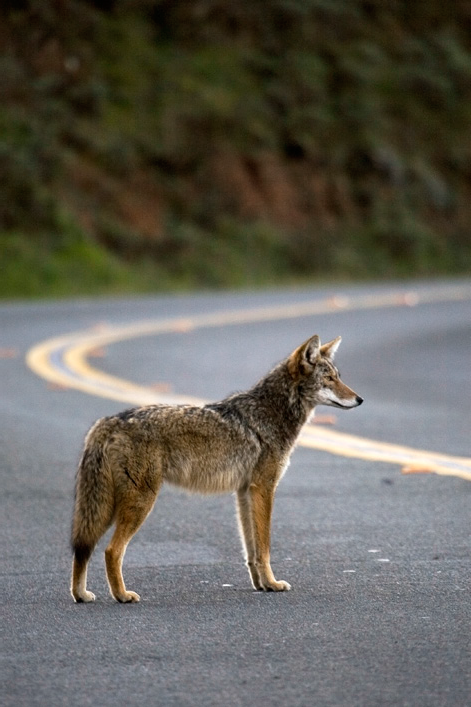Photo: Coyotes now inhabit every U.S. state except Hawaii and have adapted to life with people even in the most densely populated cities. (John Harrison)
The urban coyotes of Denver were getting a bad reputation. An increasing number were moving into the city and human-inhabited areas of the surrounding county. Negative interactions between pets and coyotes were on the rise. Over the course of about two years, four highly publicized incidents in Colorado of coyotes biting people fed the perception that urban coyotes were a growing menace. Indeed, in Denver at least, coyotes were beginning to show less fear and far bolder behaviors in the presence of humans. When, in February of 2009, a woman told reporters she was attacked and bitten by three coyotes while walking her Labrador retriever in her southeast Denver neighborhood, it spurred calls for action. “Action,” in such cases, often leads to dead wildlife.
Photo: Coyotes give birth in the spring, and this is the time when coyote parents may be more territorial and protective of their den sites and pups. From April to July, dog walkers should try to avoid known coyote den site areas and should walk dogs on leashes in such areas to avoid conflicts. (John Harrison)
That’s when Denver’s Parks & Recreation Department (DPR) stepped in—to see if it could “broker a deal” between the more domesticated residents of Denver (both human and animal) and the wild canines that were intent on moving back into what once may have been their neighborhood. Research and evidence from other urban areas convinced DPR that killing or trapping and relocating the coyotes would not be effective. More would move in, and the problems would just be repeated. Instead, DPR wanted a chance to “teach” resident coyotes how to live beside their human neighbors without getting into trouble. To do that, they also needed to teach the humans how to behave around coyotes.
A plan was put into place and now, over a year later, is deemed a success. Coyotes are still around, but they are acting more like their old selves and less like urban toughs. And humans are learning what they need to do to keep negative interactions to a minimum. Camilla Fox, AWI Wildlife Consultant and founder of Project Coyote, calls Denver “a trend-setter when it comes to human-coyote coexistence.”
To find out what Denver did to make this human/coyote relationship more harmonious, Fox recently spoke with Ashley DeLaup, Wildlife Ecologist with Parks and Recreation of the City and County of Denver. DeLaup is responsible for much of the plan’s ongoing success. She joined DPR in July of 2008 as Denver’s first wildlife ecologist, responsible for the 4,000 acres administered by DPR’s “Natural Areas Division.” DeLaup is tasked specifically with encouraging peaceful coexistence between Denver’s wild and human populations. She came to DPR with an animal training background, and had worked before on redirecting the behavior of wild animals. DeLaup explains to Fox how Denver created a plan and continues to help coyotes and humans coexist:
Fox: How did Denver’s coyote management plan come about?
DeLaup: We drew on a vast amount of existing knowledge about coyote ecology and newer knowledge about how they behave in an urban environment, and just applied that knowledge to how we could best reduce conflicts with them. Our first step was trying to accumulate facts about the danger from coyotes and determine what would be needed to reduce encounters. Data clearly showed that human injuries from coyotes were extremely rare, and there were usually preventable circumstances if people had the right information about living in coyote territory. Danger to pets was real and people needed tips on how to protect pets. So quickly the focus turned to four initiatives: 1) creating a reasonable and realistic understanding of coyote behavior and coyote danger; 2) keeping pets safe; 3) changing the behaviors of the coyotes that scared people; and 4) educating people on ways that they can decrease negative encounters with coyotes whether in their backyard (reducing wildlife attractants) or out on the trail in open space.
Photo: Ashley DeLaup, Wildlife Ecologist, demonstrates a variety of coyote hazing tools. (Parks and Recreation of the City and County of Denver)
Fox: Denver incorporates “hazing” into its coyote management plan. What is hazing and what are the goals of this practice?
DeLaup: Hazing is about persistently and consistently providing an aversive response to the presence of coyotes when they have become habituated to the presence of people. People can yell, bang pots, blow whistles or air horns, throw sticks, and generally be something that animals want to avoid. Hazing does not chase animals out of a territory, nor does it harm the animal. Territory is precious to animals and they need those resources for survival, but they can be out at 2 a.m. instead of 8 a.m. So if they are always harassed at 8 a.m. they’ll learn not to be out at that time. Harming an animal, on the other hand, makes it unpredictable, and killing the animal just opens that space up for a new coyote.
Coyotes are incredibly intelligent, and they have learned how to thrive in close proximity to people. They can and will continue to learn how to survive in an urban environment. People have been “teaching” coyotes for years how to act without realizing it. Every time a coyote has encountered a person up close in an urban setting and has not had any negative consequences, the coyote has learned that it’s not scary to be close to people. Interacting with people and pets and being seen in close proximity to people is a learned behavior, not a natural behavior. The goals of hazing are to reshape coyote behavior to avoid human contact and to give residents tools to help them feel more in control and less afraid of encountering coyotes.
Photo: This coyote pup was mistaken for a domestic dog pup and brought to Denver Parks & Recreation staff. He was successfully released back into the wild, but some are not so fortunate when removed from their families. (Parks and Recreation of the City and County of Denver)
Fox: From your experience, is “hazing” effective in changing coyote behavior or “re-wildling” a coyote who has become too comfortable around people?
DeLaup: So far hazing has been very successful in Denver when done properly and consistently. We had one park where the family group of coyotes was seen out daily and had begun approaching pets on leash and attacking unattended pets in yards in the adjacent neighborhoods. Both outdoor dogs and cats had been injured and killed by the coyotes and people were terrified and angry. About 20 Denver parks staff members were trained in hazing coyotes and we put together a “coyote hazing tool kit.” Every morning, one to three staff members went to the park during early morning “dog walking” hours with the intent to look for the coyotes and haze them. Staff “hazers” were also trained on explaining what they were doing, why they were doing it, and how park locals could help with the hazing. After about three weeks we noticed that staff hardly saw the coyotes at all. By the fourth and fifth week we realized that coyotes both identified our vehicles and knew that they didn’t want to be in the park that time of day, and we stopped staff hazing.
Concurrently with this, we offered training to residents at the park and went to local homeowners group meetings in the areas as well, and residents effectively began hazing themselves. It’s been over a year since that time, and now we rarely get calls of sightings from this park. One resident recently called me, upset because she never sees the coyotes anymore and she thought we had removed them! Meanwhile the coyotes are definitely still there, and in fact have a natal den in the park and continue to provide the ecological services without the contact with their neighbors.
Photo: Road mortality is one of the leading causes of death for coyotes living in urban areas. Research indicates that coyotes have become more nocturnal in urban areas to avoid roads and other human-related hazards, though it is not uncommon or unnatural to see coyotes during the day. (Trish Carney)
Fox: In your opinion, what does “human-coyote coexistence” look like in an urban/suburban landscape?
DeLaup: It’s an active and educated process. We “coexist” with our human neighbors because we understand and obey certain “rules” such as not throwing trash into someone’s yard, parking on their grass, or playing loud music in the middle of the night. Creating and enforcing expectations of our coyote population by hazing them and understanding normal vs. abnormal coyote behavior can set us up to succeed in reducing urban coyote conflicts.
People need to develop reasonable expectations such as understanding that coyotes are finding resources here and they will be someplace. We can help decide where those places are by hazing in unsuitable locations, and supporting healthy open space and natural areas nearby that will be much more attractive and safe for them. We also need to realize that as much as our pets are a part of our family, a city is a functional ecosystem, and any animal there can become a part of it if unattended. And pets are often less able to protect themselves than other wildlife that was raised with an awareness of the dangers of life.
Coyotes are a new urban reality, and the more we understand them and their new role, the better we can shape a successful and functioning ecosystem in our own backyards.
Originally reported by Camilla H. Fox in an interview with Ashley DeLaup.

